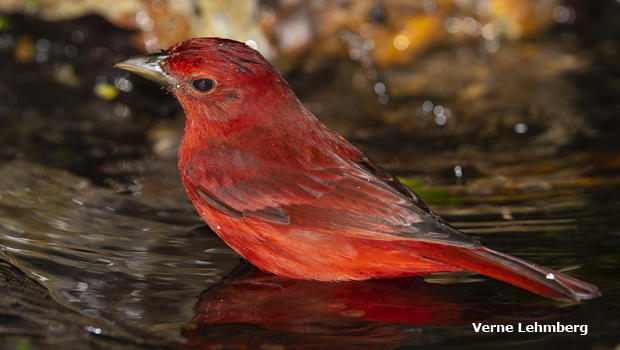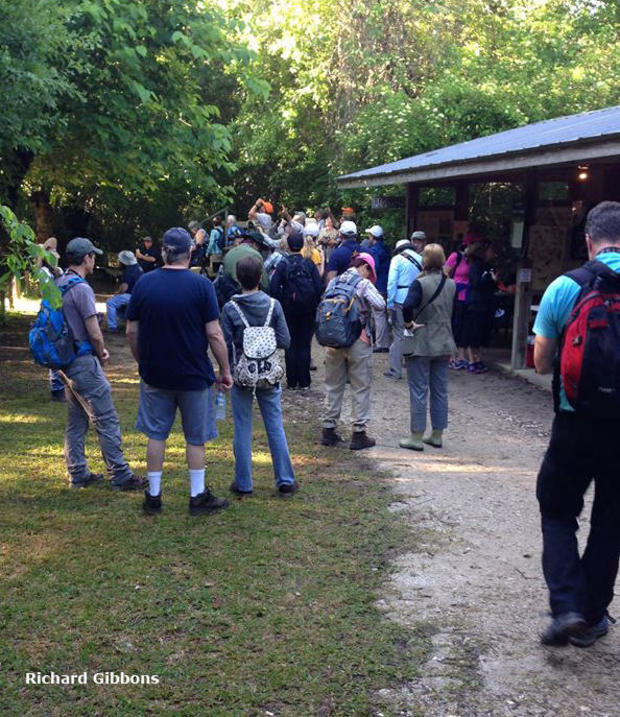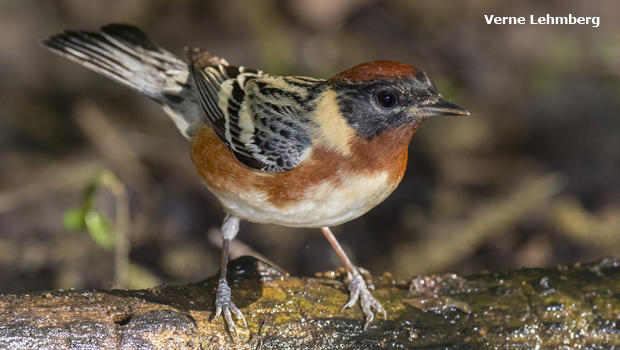Nature up close: Bird watchers' meccas in Texas
By "Sunday Morning" contributing videographer Judy Lehmberg.
If you see bleachers you normally think sports; you usually don't think of bird watching. You would if you were in the Houston Audubon Society's Boy Scout Woods in High Island, Texas in April. They have bleachers facing a water drip and surrounded on three sides by fruiting mulberry trees. Sit there for a few minutes, and you will hear people quietly calling out birds they've spotted: Summer tanager in the mulberry on the left, right side, lowest branch; male rose-breasted grosbeak in the right mulberry dead center above the V notch; chestnut-sided warbler at the water; Oh look! There's a painted bunting at the drip! That's a lifer for me!
Many North American songbirds – especially warblers, vireos, thrushes, tanagers, buntings and orioles – reproduce in our hemisphere, but winter in Central and South America. They begin their northern migration in March, their numbers peaking in April, with some still migrating in early May.
I've been bird watching during spring migration in High Island, Texas, where both Boy Scout Woods and Smith Oaks are located, since the mid-1970s, well before the Houston Audubon Society purchased both properties.
High Island isn't really an island; it is a small town located between Port Arthur and Galveston only a few hundred yards from the coast. Because it is on a salt dome almost 40 feet high – the highest point between Mobile, Alabama and the Yucatan Peninsula – it supports the growth of trees unlike the surrounding area which is coastal prairies and salt marsh. The trees are a magnet for migrating birds who leave Mexico just after sunset and fly nonstop over 600 miles to the Texas coast. That normally takes about 18 hours. If the wind is strong out of the south, they may continue their journey north, but if it changes to out of the north, particularly after the birds have left Mexico, they stop in the High Island trees to rest, refuel and drink fresh water. That is why this habitat is so essential for their survival.
A north wind is deadly for migrating birds. No one knows the exact number, but many don't make it across the Gulf when the wind is blowing hard out of the north. But it is a different matter for bird watchers: Although they are mindful of the stress it causes the birds, a "fall out" is an amazing spectacle for bird watchers. For as many years as I have been visiting High Island I've never seen the numbers I've heard about when the beach, the school parking lot and every patch of grass is covered with bright blue indigo buntings, red summer tanagers, warblers in every shade of black, blue, yellow and white, as well as many other species. My record so far is 22 species of warblers in one day. Although I felt bad for the birds, it was a spectacle I will never forget.
There is always a predictable order to spring migration. Hummingbirds are some of the first to show up in Texas. Usually the males come first (the scouts, as a friend of mine calls them), then the females. They always seem to know when flowers begin blooming, and that's when they magically appear.
Then comes a long procession of warblers and vireos. White-eyed vireos, northern parulas and prothonotary warblers are usually the first in our part of southeast Texas. When they show up we know the migration is on.
They are quickly followed by worm-eating Louisiana waterthrush (which, despite its name, is a warbler), Kentucky, and hooded warblers. By mid-April chestnut-sided, Blackburnian, blue-winged and golden-winged warblers have become more numerous, and that is usually about the time the mulberries begin to ripen, so the orioles, tanagers and grosbeaks become more common.
Over the years the Houston Audubon Society has added land to both Boy Scout Woods, now 60 acres, and Smith Oaks, which is now 177 acres. Smith Oaks has a great bird rookery, some beautiful large oak trees, photography and observation platforms to view the rookery birds, and this spring a canopy walkway will be available. I can't wait to experience that. They also own five other preserves in High Island as well as Bolivar Flats, a great place to view shorebirds in breeding plumage. If you get a chance to visit you will find some very friendly volunteers at both of the above locations who can direct you to other bird watching spots.
For more info:
- If you would like to learn more about spring migration and/or plan a trip to High Island, the Houston Audubon Society's website is a good place to start. High Island is a small town with very little infrastructure. There is a gas station/convenience store and a campground with RV hookups that fills up fast in April. There are hotels and restaurants in Winnie, twenty miles north.
- Cornell Lab of Ornithology is another great source of information.
- A number of years ago it was discovered that migrating birds can be seen on weather radar. Over the last 20-plus years scientists' ability to see migrating birds this way has led to a number of discoveries. Most bird migration happens at night. Cornell Lab of Ornithology along with other researchers and donors have created BirdCast, where each night's radar is summarized in a dynamic map which includes arrows showing the direction in which birds are moving; an estimate of the number of birds per hour in all areas of the U.S.; and the areas with high migration rates. Now they even have a migration forecast that combines weather forecasts with over twenty years of spring migration data – a real boon for serious birders.
- Another Cornell site, eBird, provides lists of birds seen in a particular area on specific dates and BirdCast actually allows you to plan trips based on when bird migration will be the heaviest.
Judy Lehmberg is a former college biology teacher who now shoots nature videos.
See also:
- Judy Lehmberg (Official site)
- Judy Lehmberg's YouTube Channel
To watch extended "Sunday Morning" Nature videos click here!








